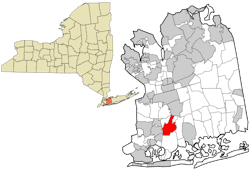Microgrid Project Profile: How NY’s Rockville Centre Could Avoid $68M in Transmission Upgrades
The Village of Rockville Centre (RVC), NY has proposed a $14.7 million microgrid to ensure a reliable supply of electricity to first responders, key businesses and a broad base of other customers during regional power outages.
RVC says it will be able to defer $50-$68 million in upgrades to existing electric transmission lines if it installs the microgrid, according to its project feasibility study, filed with the state of New York as part of NY Prize.
The microgrid includes new distributed energy resources in the form of a reciprocating engine generator, solar photovoltaics (PV) and demand-side management programs.
Located in southwestern Long Island, the village of just over 24,000 residents has identified a need for the microgrid on Bus 2 of its power distribution system. Bus 2 serves several critical facilities, including health care facilities, police and fire stations, water pumps, street lights and traffic signals. The bus also serves nearly 3,000 residential customers (including 11 customers requiring life support) and 500 commercial customers.
RVC could not supply power to all of the critical loads on Bus 2 during past power outages, such as those brought on by Superstorm Sandy in 2012. Two problems plagued the village: (1) the existing generators on Bus 2 do not have black-start (emergency startup) capability; or (2) the existing generators could only supply power to Bus 1.
The microgrid project will improve RVC’s capability to respond to a regional outage, primarily due to a new, highly efficient 7-8 MW gas-fired reciprocating engine generator. With the microgrid, the RVC Electric Department will have the ability to selectively deliver and prioritize power to specific circuits on Bus 2 and isolate damaged portions of the circuit as required.
[clickToTweet tweet=”NY village says it can avoid $50-$68 million in transmission upgrades with a #microgrid. ” quote=”NY village says it can avoid $50-$68 million in transmission upgrades with a microgrid. “]
In the case of a power transmission line disruption, Bus 2 will be isolated from the main Long Island grid and other distribution loads. Upon confirmation that the RVC microgrid was not harmed by the power interruption, the new generator will be placed into islanding mode and started using its black-start capability. The existing generators that lack black-start capability will be started once the main power plant house loads are energized.
Rockville Centre within New York State (left) and within Nassau County (right). Credit: Wikimedia Commons
RVC expects the microgrid to save the community about $1.6 million in electricity costs, much of it by generating power below grid prices during periods of peak demand on the grid, according to a feasibility study completed with $100,000 from the NY Prize.
The microgrid project also includes:
- A combined heat & power component (CHP) plant, which will reduce need to operate an oil-fired boiler by about 58 percent, and result in an estimated annual fuel savings of 24,360 gallons of oil. At a fuel cost of about $2/gal, the CHP system will displace an estimated $48,720 per year in fuel oil costs and 150 metric tons per year of carbon dioxide (C02) emissions.
- Up to 568 kW of rooftop solar on RVC controlled buildings to help offset utility load growth, supplement conventional generation during the daytime and lower C02, carbon monoxide and nitrogen oxide emissions.
- A demand side management program that will reduce the peak load, during both islanded and normal mode, and possibly offset future load growth
The source of this information is the NY Prize Feasibility Studies, NYSERDA.
Track microgrid projects by signing up for the free Microgrid Knowledge newsletter.
